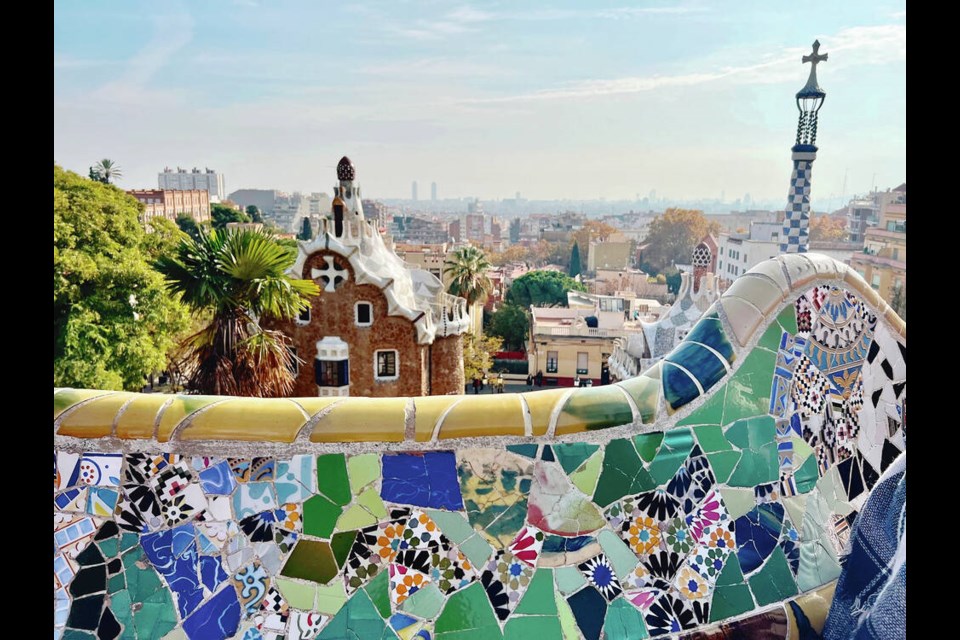Nothing beats sitting on the back of a dragon sipping wine.
Which is where I found myself in Barcelona, Spain, while touring Casa Batllo, the most extraordinary home I’ve ever visited, with its undulating, whimsical rooftop, complete with dragon scales, and skull-like balconies representing the dragon’s victims.
To arrive at my prime viewing spot on the outdoor, rooftop terrace, I passed through an interior hallway of arches meant to evoke the dragon’s ribcage.
Casa Batllo, also nicknamed “House of Dragon” and “House of Bones,” was designed by Barcelona’s most famous architect Antoni Gaudi, who created the colourful roofline, crowned by a cross, as an allegory depicting the battle between the Patron Saint of Catalonia, Saint George, and a dragon.
This fairy-tale, fantastical private residence was once the home of wealthy Barcelona businessman Josep Batllo, who bought what was originally an austere house in 1904, but wanted a residence to rival all the other fine homes on Passeig de Gracia, a new boulevard where the rich lived.
To do that, he commissioned Gaudi to refurbish the house. After two years, the house was completely transformed with two new floors added, a new main facade of ceramic glass pieces that shimmered in the light, and a unique interior inspired by nature with no square edges or corners to be found.
Even the walls are rounded and made to look like serpent skin — yet another testimony to Gaudi’s wild imagination.
As one of the founders of the Catalan Modernism movement, known for its asymmetrical shapes and curved lines, Gaudi created work that’s easily recognizable and leaves a lasting impression.
The director of the school where Gaudi studied architecture famously said he wasn’t certain whether Gaudi was a “genius or a madman,” when he awarded him his architectural degree.
Clearly, Gaudi was a genius and seven of his works have been declared UNESCO World Heritage Sites, including Casa Batllo.
Any visitor to Barcelona would be remiss not to do an architectural tour involving some of Gaudi’s masterpieces, whether to see inside one of the amazing private homes he designed, stroll through the municipal public Park Guell he created or visit Gaudi’s biggest and most famous commission, the Sagrada Familia Basilica, the world’s largest, unfinished Catholic church.
In a city where Gaudi’s architecture is a major attraction for travellers, the following are some of his works I visited while sightseeing around Barcelona.
The Sagrada Familia Basilica
Arriving in Barcelona, it’s hard not to notice Gaudi’s Sagrada Familia Basilica, which is the city’s most famous landmark and its main religious and architectural attraction. It towers over all the nearby buildings, standing 138 metres high.
Work on the basilica began in 1882, but to date is still not completed. It’s anticipated the basilica’s final tower will be done by 2026 — on the 100th anniversary of Gaudi’s death.
He died in 1926, after being struck by a tram after finishing work that day on the Sagrada Familia. He was 73 years old. The Sagrada Familia was conceived by Gaudi, a deeply religious man, as a link between heaven and earth. In 1914, he stopped accepting other commissions to concentrate on the Sagrada Familia. The interior has 36 “forest-like” columns reaching up to heaven. Its walls decorated with large, sparkling stained glass windows, with beautiful hues of red, blue, green and yellow light providing the main source of light to its interior. According to Gaudi “straight lines belong to man, but the curved lines belong to God.” The church will have 18 spires when completed, representing the 12 apostles, the four evangelists, the Virgin Mary and Jesus Christ.
Park Guell
This magical park is really a failed housing project that Gaudi designed in 1900 to be a residential area where the elite would live on the southern slope of Mount Carmelo, with magnificent city views below.
Gaudi was commissioned by wealthy entrepreneur Eusebi Guell, where the park gets its name, to design 69 houses to be constructed here, a chapel and a theatre but with a lack of a suitable transportation system at the time only two houses were ever built, including one where Gaudi lived between 1906 and 1925, before moving into a small room in the Sagrada Familia at the end of his life. His former home in the park is now a museum, and contains furniture designed by Gaudi.
The 17-hectare park opened as a city park in 1926 and showcases many of the architectural details found in Gaudi’s work, like the mosaic glass undulating park benches, and a covered walkway with columns shaped like trees. There are many photographic points throughout the park, including the mosaic frog sculpture fountain at the main entrance.
La Pedrera or Casa Mila
This was the last private residence designed by Gaudi and is known for its stone facade and roof terrace with 28 chimneys in several groups, that look like sculptures. The stairwells and chimneys look out over an amazing city view.
Le Pedrera means “stone quarry” in Catalan. The house was finished in 1912 and took six years to complete.
Note: Tickets often sell out to see the interiors of Gaudi’s works, particularly The Segrada Familia, so it’s best to get tickets online in advance of your visit. Also, try to visit early in the day to witness the sunlight lighting up the Basilica’s interior from the many stained glass windows. The cost for a guided audio tour is about 30 Euros for an adult or $43.50 Canadian.
The entry fee to Park Guell is 10 Euros or $14.50 and the cost to visit Casa Batllo is 35 Euros or $50 Canadian, or you can pay 45 Euro or $65 Canadian for a fast past that provides entrance as well to some of the family’s private furnished rooms. I opted for the gold pass and felt, while the price was high, it was worth it to allow me to fully explore this extraordinary home.



